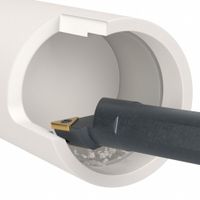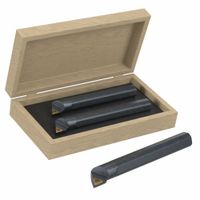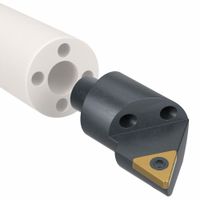Call +(254) 703 030 000 / 751 483 999 / 721 704 777
- Home
- Machining
- Indexable Cutting Tools
- Indexable Boring
.....Read More
Frequently Asked Questions
What are indexable boring tools used for?
Indexable boring tools are used in machining operations to enlarge or finish the inside diameter of a pre-existing hole. These tools are equipped with replaceable cutting inserts that can be indexed, or rotated, to present a fresh cutting edge, enhancing tool life and reducing downtime. They are commonly used in industries such as automotive, aerospace, and manufacturing for precision boring tasks.
The primary function of indexable boring tools is to achieve high precision and surface finish in the boring process. They are designed to handle various materials, including metals, plastics, and composites, making them versatile for different applications. The ability to replace inserts without removing the tool from the machine increases efficiency and productivity.
Indexable boring tools come in various configurations, including single-point and multi-point designs, to accommodate different hole sizes and depths. They are often used in CNC machines and lathes, where precise control over the cutting process is required. The tools can be adjusted for different cutting conditions, such as speed and feed rate, to optimize performance and extend tool life.
In summary, indexable boring tools are essential for precision machining, offering flexibility, efficiency, and cost-effectiveness in producing high-quality internal surfaces.
How do indexable boring tools differ from standard boring tools?
Indexable boring tools differ from standard boring tools primarily in their design and functionality.
1. **Cutting Inserts**: Indexable boring tools use replaceable cutting inserts, typically made from carbide or other hard materials. These inserts can be rotated or flipped to present a fresh cutting edge, extending the tool's life without needing regrinding. Standard boring tools, on the other hand, often have a single, fixed cutting edge that requires sharpening or replacement when worn.
2. **Cost Efficiency**: While the initial cost of indexable tools may be higher, they are more cost-effective over time due to the replaceable inserts. Standard tools may incur higher maintenance costs due to frequent sharpening or replacement.
3. **Versatility**: Indexable tools offer greater versatility as they can accommodate different insert geometries and grades for various materials and applications. This adaptability allows for quick changes to optimize performance for specific tasks. Standard tools are generally less adaptable, often requiring a different tool for each specific application.
4. **Precision and Surface Finish**: Indexable tools can achieve high precision and superior surface finishes due to the consistent quality of the inserts. Standard tools may struggle to maintain the same level of precision and finish as they wear down.
5. **Setup and Changeover Time**: Indexable tools reduce setup and changeover time since inserts can be quickly replaced without removing the tool from the machine. Standard tools may require more downtime for sharpening or replacement.
6. **Tool Life and Performance**: The ability to use multiple cutting edges on an insert enhances the tool life and performance of indexable tools. Standard tools may have a shorter lifespan due to the single cutting edge.
In summary, indexable boring tools offer enhanced efficiency, versatility, and cost-effectiveness compared to standard boring tools, making them a preferred choice in many industrial applications.
What are the benefits of using indexable boring tools?
Indexable boring tools offer several benefits in machining operations:
1. **Cost Efficiency**: Indexable tools have replaceable inserts, reducing the need to replace the entire tool. This lowers tooling costs and minimizes downtime for tool changes.
2. **Versatility**: These tools can accommodate various insert geometries and grades, allowing for a wide range of materials and applications. This adaptability makes them suitable for different boring operations without needing multiple tools.
3. **Precision and Consistency**: Indexable boring tools provide high precision and consistent performance. The inserts are manufactured to tight tolerances, ensuring uniformity in machining operations and improving the quality of the finished product.
4. **Reduced Downtime**: Quick and easy insert changes minimize machine downtime. Operators can replace worn inserts without removing the tool from the machine, enhancing productivity and efficiency.
5. **Improved Surface Finish**: The sharp, precise cutting edges of indexable inserts contribute to superior surface finishes. This reduces the need for additional finishing operations, saving time and resources.
6. **Enhanced Tool Life**: The use of advanced materials and coatings on inserts extends tool life. This durability reduces the frequency of insert changes and contributes to overall cost savings.
7. **Flexibility in Operations**: Indexable boring tools can be used for roughing and finishing operations, providing flexibility in machining processes. This versatility allows for streamlined operations and reduced inventory of different tools.
8. **Optimized Performance**: The ability to select specific insert geometries and coatings tailored to the material and application optimizes cutting performance, improving efficiency and reducing wear.
9. **Environmental Benefits**: By reducing the need for complete tool replacements, indexable tools contribute to less waste, supporting sustainable manufacturing practices.
How do you change the inserts on an indexable boring tool?
1. **Safety First**: Ensure the machine is turned off and the tool is cool. Wear safety gloves and goggles.
2. **Secure the Tool**: Remove the boring tool from the machine and secure it in a vice or on a stable workbench to prevent movement.
3. **Identify the Insert**: Locate the indexable insert on the boring tool. It is typically held in place by a screw or clamp.
4. **Loosen the Screw/Clamp**: Use the appropriate tool, usually a Torx or Allen wrench, to loosen the screw or clamp holding the insert. Turn counterclockwise to loosen.
5. **Remove the Insert**: Carefully remove the old insert. Note its orientation and position for correct installation of the new insert.
6. **Clean the Pocket**: Use a brush or compressed air to clean the insert pocket, removing any debris or residue to ensure proper seating of the new insert.
7. **Select the New Insert**: Choose the correct replacement insert, ensuring it matches the specifications required for your application.
8. **Install the New Insert**: Place the new insert into the pocket, aligning it correctly as per the original orientation.
9. **Tighten the Screw/Clamp**: Secure the insert by tightening the screw or clamp. Turn clockwise until snug, but avoid over-tightening to prevent damage.
10. **Inspect the Setup**: Check the insert for proper seating and alignment. Ensure there is no movement or misalignment.
11. **Reinstall the Tool**: Place the boring tool back into the machine, ensuring it is properly secured.
12. **Test the Tool**: Run a test cut to ensure the insert is functioning correctly and the tool is operating smoothly.
13. **Adjust if Necessary**: If there are issues, recheck the insert installation and make necessary adjustments.
What materials can indexable boring tools work with?
Indexable boring tools can work with a wide range of materials, including:
1. **Steel**: Both carbon and alloy steels are commonly machined using indexable boring tools. These tools are designed to handle the toughness and strength of steel, making them suitable for automotive and industrial applications.
2. **Stainless Steel**: Indexable boring tools can effectively machine various grades of stainless steel, which are known for their corrosion resistance and strength.
3. **Cast Iron**: These tools are well-suited for machining cast iron, including gray, ductile, and malleable cast iron, due to their ability to handle the abrasive nature of the material.
4. **Aluminum**: Lightweight and easy to machine, aluminum and its alloys are frequently worked on with indexable boring tools, especially in the aerospace and automotive industries.
5. **Titanium**: Although challenging due to its strength and tendency to work harden, titanium can be machined with specialized indexable boring tools designed to handle its unique properties.
6. **Brass and Bronze**: These non-ferrous metals are easily machined with indexable boring tools, often used in plumbing and decorative applications.
7. **Copper**: Known for its excellent thermal and electrical conductivity, copper can be machined with indexable boring tools, though care must be taken to manage its tendency to stick to cutting tools.
8. **Plastics**: Various plastics, including thermoplastics and thermosetting plastics, can be machined using indexable boring tools, often requiring specific tool geometries to prevent melting or deformation.
9. **Composites**: Advanced composites, such as carbon fiber-reinforced polymers, can be machined with indexable boring tools, though specialized inserts may be necessary to handle the abrasive nature of these materials.
10. **Superalloys**: High-performance superalloys used in aerospace and power generation can be machined with indexable boring tools designed to withstand high temperatures and stresses.
What are the different types of indexable boring tools?
Indexable boring tools are essential in machining for enlarging or finishing holes with precision. The different types include:
1. **Boring Bars**: These are the most common type, featuring a shank and a cutting head with replaceable inserts. They are used for internal turning operations and can vary in length and diameter to suit different hole sizes.
2. **Cartridge Boring Tools**: These tools have a modular design where the cutting insert is mounted on a cartridge. This allows for easy adjustment and replacement, making them suitable for a range of boring operations.
3. **Twin Cutter Boring Tools**: Equipped with two cutting inserts, these tools provide balanced cutting forces, reducing vibration and improving surface finish. They are ideal for larger diameter holes.
4. **Fine Boring Tools**: Designed for high precision and fine surface finishes, these tools allow for micro-adjustments to achieve exact dimensions. They are often used in finishing operations.
5. **Rough Boring Tools**: These are used for removing large amounts of material quickly. They are robust and designed to handle heavy cutting loads, preparing the hole for subsequent finishing operations.
6. **Adjustable Boring Heads**: These tools allow for precise diameter adjustments, making them versatile for different hole sizes. They are often used in CNC machines for high precision work.
7. **Back Boring Tools**: Used for machining the back side of a hole or feature, these tools are designed to reach areas that are otherwise inaccessible with standard boring tools.
8. **Micro Boring Tools**: These are specialized for small diameter holes, providing high precision and fine finishes in delicate operations.
Each type of indexable boring tool is designed to meet specific machining requirements, offering flexibility, precision, and efficiency in various industrial applications.
How do you select the right indexable boring tool for a specific application?
Selecting the right indexable boring tool involves several key considerations to ensure optimal performance and efficiency:
1. **Material of Workpiece**: Identify the material you are working with, such as steel, aluminum, or cast iron. Different materials require specific cutting tool materials and coatings to handle their unique properties.
2. **Bore Diameter and Depth**: Determine the diameter and depth of the bore. This will influence the size and type of boring bar needed. Ensure the tool can reach the required depth without deflection.
3. **Machine Compatibility**: Check the compatibility of the tool with your machine's spindle and tool holder. Ensure the tool's shank size and type match your machine's specifications.
4. **Cutting Conditions**: Consider the cutting speed, feed rate, and depth of cut. These parameters will affect the choice of insert geometry and grade. Choose inserts that can withstand the specific cutting conditions.
5. **Surface Finish Requirements**: Determine the required surface finish of the bore. For high-quality finishes, select tools with fine-grain inserts and appropriate nose radius.
6. **Tool Rigidity and Stability**: Ensure the tool offers sufficient rigidity to minimize vibration and chatter, which can affect precision and surface finish. Choose a tool with a robust design and appropriate overhang length.
7. **Insert Geometry and Grade**: Select the insert geometry (e.g., positive or negative rake) and grade based on the material and cutting conditions. Consider coatings that enhance wear resistance and tool life.
8. **Cost and Availability**: Evaluate the cost-effectiveness of the tool and the availability of replacement inserts. Consider the tool's lifespan and the cost per part produced.
9. **Manufacturer Support**: Choose tools from reputable manufacturers that offer technical support and guidance for tool selection and application.
By carefully considering these factors, you can select an indexable boring tool that meets the specific requirements of your application, ensuring efficiency and precision in your machining operations.


